The 2012 MacBook Air (11 & 13-inch) Review
by Anand Lal Shimpi on July 16, 2012 12:53 PM EST- Posted in
- Apple
- Mac
- MacBook Air
- Laptops
- Notebooks
The More Complicated (yet predictable) SSD Lottery
Apple continues to use a custom form factor and interface for the SSDs in the MacBook Air. This generation Apple opted for a new connector, so you can't swap drives between 2011 and 2012 models. I'd always heard reports of issues with the old connector from a manufacturing standpoint, so the change makes sense. The new SSD connector looks to be identical to the one used by the Retina Display equipped MacBook Pro, although rest of the SSD PCB is different.

The Toshiba Branded SandForce SF-2200 controller in the 2012 MacBook Air - iFixit
As always there are two SSD controller vendors populating the drives in the new MacBook Air: Toshiba and Samsung. The Samsung drives use the same PM830 controller found in the 2012 MacBook Pro as well as the MacBook Pro with Retina Display. The Toshiba drives use a rebranded SandForce SF-2200 controller. Both solutions support 6Gbps SATA and both are capable of reaching Apple's advertised 500MB/s sequential access claims.
While in the past we've recommended the Samsung over the Toshiba based drives, things are a bit more complicated this round because of the controller vendor Toshiba decided to partner with.

The write/recycle path in NAND flash based SSD
Samsung's PM830 works just like any other SSD controller. To the OS it presents itself as storage with logical block addresses starting from 0 all the way up to the full capacity of the drive. Reads and writes come in at specific addresses, and the controller maps those addresses to blocks and pages in its array of NAND flash. Every write that comes in results in data written to NAND. Those of you who have read our big SSD articles in the past know that NAND is written to at the page level (these days pages are 8KB in size), but can only be erased at the block level (typically 512 pages, or 4MB). This write/erase mismatch combined with the fact that each block as a finite number of program/erase cycles it can endure is what makes building a good SSD controller so difficult. In the best case scenario, the PM830 will maintain a 1:1 ratio of what the OS tells it to write to NAND and what it actually ends up writing. In the event that the controller needs to erase and re-write a block to optimally place data, it will actually end up writing more to NAND than the OS requested of it. This is referred to as write amplification, and is responsible for the performance degradation over time that you may have heard of when it comes to SSDs.
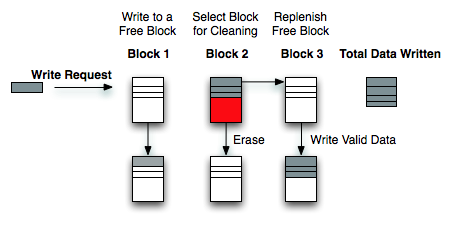
Write Amplification
For most client workloads, with sufficient free space on your drive, Samsung's PM830 can keep write amplification reasonably low. If you fill the drive and/or throw a fragmented enough workload at it, the PM830 doesn't actually behave all that gracefully. Very few controllers do, but the PM830 isn't one of the best in this regard. My only advice is to try and keep around 20% of your drive free at all times. You can get by with less if you are mostly reading from your drive or if most of your writes are just big sequential blocks (e.g. copying big movies around). I explain the relationship between free space and write amplification here.

Write Amplification vs. Spare Area, courtesy of IBM Zurich Research Laboratory
The Toshiba controller works a bit different. As I already mentioned, Toshiba's controller is actually a rebranded SandForce controller. SandForce's claim to fame is the ability to commit less data to NAND than your OS writes to the drive. The controller achieves this by using a hardware accelerated compression/data de-duplication engine that sees everything in the IO stream.
The drive still presents itself as traditional storage with an array of logical block addresses. The controller still keeps track of mapping LBAs to NAND pages and blocks. However, because of the compression/dedupe engine, not all data that's written to the controller is actually written to NAND. Anything that's compressible, is compressed before being written. It's decompressed on the fly when it's read back. All of the data is still tracked, the drive still is and appears to be the capacity that is advertised (you don't get any extra space), you just get extra performance. After all, writing nothing is always faster than writing something.
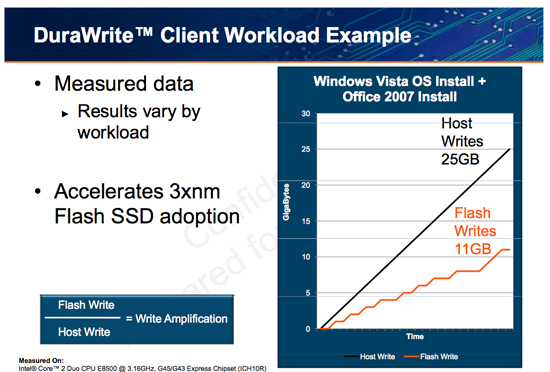
Writing less data to NAND can improve performance over time by keeping write amplification low. There are also impacts on NAND endurance, but as I've shown in the past, endurance isn't a concern for client drives and usage models. Writing less also results in a slight reduction in component count: there's no external DRAM found on SandForce based drives. The PM830 SSD features a 256MB DDR2 device on-board, while the Toshiba based drive has nothing - just NAND and the controller. This doesn't end up making the Toshiba drive substantially cheaper as SandForce instead charges a premium for its controller. In the case of the PM830, both user data and LBA-to-NAND mapping tables are cached in DRAM. In the case of the Toshiba drive, a smaller on-chip cache is used since there's typically less data being written to the NAND itself.
SandForce's approach is also unique in that performance varies depending on the composition of the data written to the drive.
PC users should be well familiar with SandForce's limitations, but this is the first time that Apple has officially supported the controller under OS X. As such I thought I'd highlight some of the limitations so everyone knows exactly what they're getting into.
Any data that's random in composition, or already heavily compressed, isn't further reduced by Toshiba's SandForce controller. As SandForce's architecture is designed around the assumption that most of what we interact with is easily compressible, when a SF controller encounters data that can't be compressed it performs a lot slower.
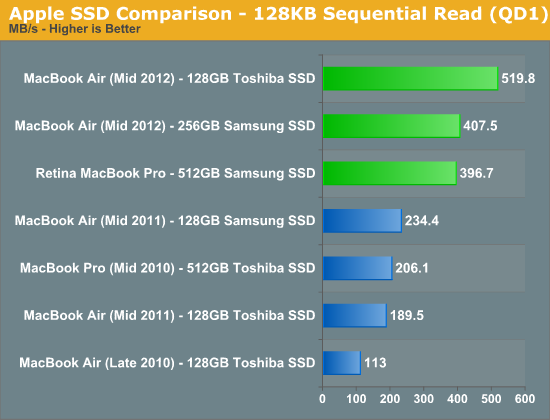
Special thanks to AnandTech reader KPOM for providing the 256GB Samsung results
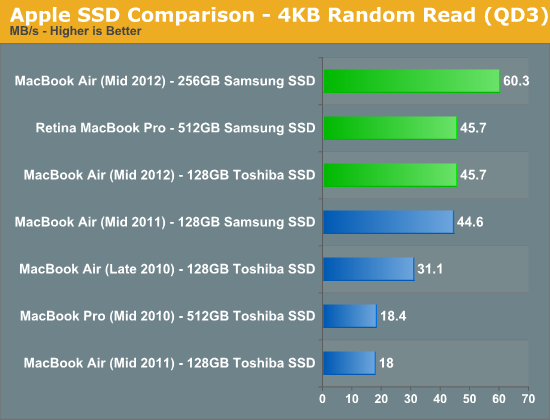
The performance impact is pretty much limited to writing. We typically use Iometer to measure IO performance as it's an incredibly powerful tool. You can define transfer size, transfer locality (from purely sequential all the way to purely random) and even limit your tests to specific portions of the drive, among other features. Later versions of Iometer introduced the ability to customize the composition of each IO transfer. For simplicity, whenever Iometer goes to write anything to disk it's a series of repeating bytes (all 0s, all 1s, etc...). Prior to SandForce based SSDs this didn't really matter. SandForce's engine will reduce these IOs to their simplest form. A series of repeating bytes can easily be represented in a smaller form (one byte and a record of how many times it repeats). Left at its default settings, SandForce drives look amazing in Iometer - even faster than the PM830 based Samsung drive that Apple uses. Even more impressive, since very little data is actually being written to the drive, you can run default Iometer workloads for hours (if not days) on end without any degradation in performance. Doing so only tells us part of the story. While frequently used OS and application files are easily compressed, most files aren't.
Thankfully, later versions of Iometer include the ability to use random data in each transfer. There's still room for some further compression or deduplication, but it's significantly reduced. In the write speed charts below you'll see two bars for the Toshiba based SSD, the one marked incompressible uses Iometer's random data setting, the other one uses the default write pattern.
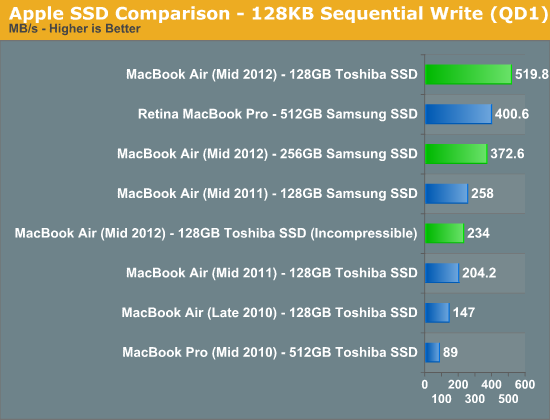
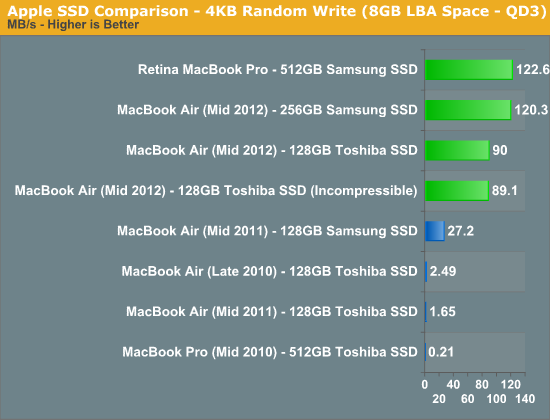
When fed easily compressible data, the Toshiba/SandForce SSD performs insanely well. Even at low queue depths it's able to hit Apple's advertised "up-to" performance spec of 500MB/s. Random write performance isn't actually as good as Samsung's, but it's more likely to maintain these performance levels over time.
Therein lies the primary motivator behind SandForce's approach to flash controller architecture. Large sequential transfers are more likely to be heavily compressed (e.g. movies, music, photos), while the small, pseudo-random accesses are more likely easily compressible. The former is rather easy for a SSD controller to write at high speeds. Break up the large transfer, stripe it across all available NAND die, write as quickly as possible. The mapping from logical block addresses to pages in NAND flash is also incredibly simple. Fewer entries are needed in mapping tables, making the read and write of these large files incredibly easy to track/manage. It's the small, pseudo-random operations that cause problems. The controller has to combine a bunch of unrelated IOs in order to get good performance, which unfortunately leaves the array of flash in a highly fragmented state - bringing performance down for future IO operations. If SandForce's compression can reduce the number of these small IOs (which it manages to do very well in practice), then the burden really shifts to dealing with large sequential transfers - something even the worst controllers can do well.
It's really a very clever technology, one that has been unfortunately marred by a bunch of really bad firmware problems (mostly limited to PCs it seems).
The downside in practice is the performance when faced with these incompressible workloads. Our 4KB random write test doesn't actually drop in performance, but if we ran it for long enough you'd see a significant decrease in performance. The sequential write test however shows an immediate reduction of more than half. If you've been wondering why your Toshiba SSD benchmarks slower than someone else's Samsung, check to see what sort of data the benchmark tool is writing to the drive. The good news is that even in this state the Toshiba drive is faster than the previous generation Apple SSDs, the bad news is the new Samsung based drive is significantly quicker.
What about in the real world? I popped two SSDs into a Promise Pegasus R6, created a RAID-0 array, and threw a 1080p transcode of the Bad Boys Blu-ray disc on the drive. I then timed how long it took to copy the movie to the Toshiba and Samsung drives over Thunderbolt:
| Real World SSD Performance with Incompressible Data | ||||
| Copy 13870MB H.264 Movie | 128GB Toshiba SSD | 512GB Samsung SSD | ||
| Transfer Time | 59.97 s | 31.59 s | ||
| Average Transfer Rate | 231.3 MB/s | 439.1 MB/s | ||
The results almost perfectly mirrored what Iometer's incompressible tests showed us (which is why I use those tests so often, they do a good job of modeling the real world). The Samsung based Apple SSD is able to complete the file copy in about half the time of the Toshiba drive. Pretty much any video you'd have on your machine will be heavily compressed, and as a result will deliver the worst case performance on the Toshiba drive.
Keep in mind that to really show this difference I had to have a very, very fast source for the transfer. Unless you've got a 6Gbps SSD over USB 3.0 or Thunderbolt, or a bunch of hard drives you're copying from, you won't see this gap. The difference is also less pronounced if you're copying from and to the same drive. Whether or not this matters to you really depends on how often you move these large compressed files around. If you do a lot of video and photo work with your Mac, it's something to pay attention to.
There's another category of users who will want to be aware of what you're getting into with the Toshiba based drive: anyone who uses FileVault or other full disk encryption software.
Remember, SandForce's technology only works on files that are easily compressed. Good encryption should make every location on your drive look like a random mess, which wreaks havoc on SandForce's technology. With FileVault enabled, all transfers look incompressible - even those small file writes that I mentioned are usually quite compressible earlier.
After enabling FileVault I ran our Iometer write tests on the drives again, performance is understandably impacted:
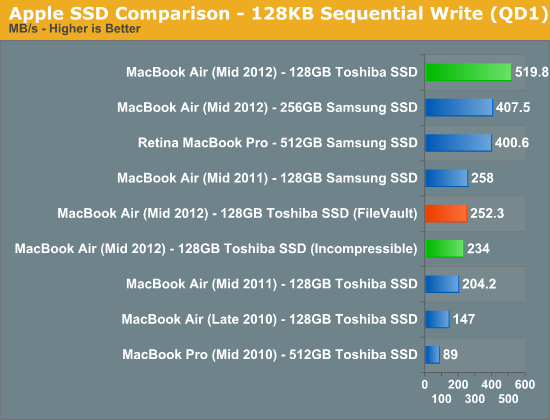
Also look at what happens to our 4KB random write test if we repeat it a few times back to back:
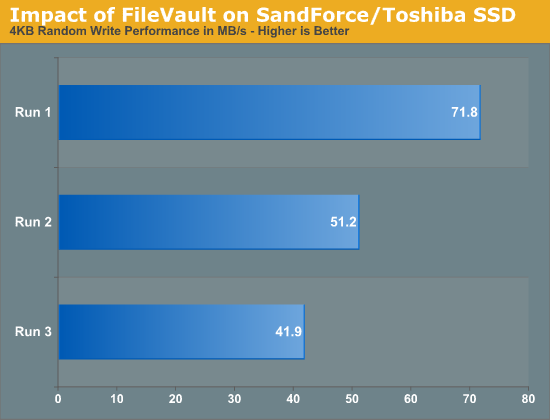
That trend will continue until the drive's random write performance is really bad. Sequential write passes will restore performance up to ~250MB/s, but it takes several passes to get it there:
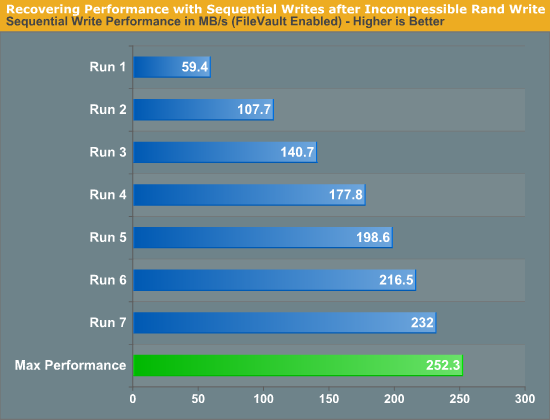
If you're going to be using FileVault, stay away from the Toshiba drive.
This brings us to the next problem: how do you tell what drive you have?
As of now Apple has two suppliers for the SSD controllers in all of its 2012 Macs: Toshiba and Samsung. If you run System Information (click the Apple icon in the upper left > About this Mac > System Report) and select Serial ATA you'll see the model of your SSD. Drives that use Toshiba's 6Gbps controller are labeled Apple SSD TSxxxE (where xxx is your capacity, e.g. TS128E for a 128GB drive), while 6Gbps Samsung drives are labeled Apple SSD SMxxxE. Unfortunately this requires you to already purchase and open up your system. It's a good thing that Apple stores are good about accepting returns.
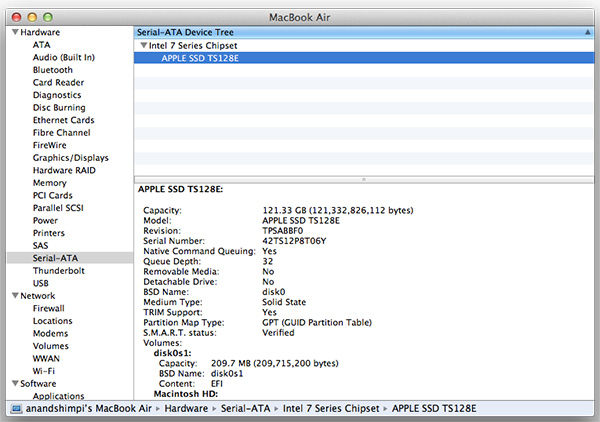
There's another option that seems to work, for now at least. It seems as if all 256GB and 512GB Apple SSDs currently use Samsung controllers, while Toshiba is limited to the 64GB and 128GB capacities. There's no telling if this trend will hold indefinitely (even now it's not a guarantee) but if you want a better chance of ending up with a Samsung based drive, seek out a 256GB or larger capacity. Note that this also means that the rMBP exclusively uses Samsung controllers, at least for now.
I can't really blame Toshiba for this as even Intel has resorted to licensing SandForce's controllers for its highest performing drives. I will say that Apple doesn't seem to be fond of inconsistent user experiences across its lineup. I wouldn't be surprised if Apple sought out a third SSD vendor at some point.










190 Comments
View All Comments
flying_butt_pliers - Monday, July 16, 2012 - link
Wow, superb on the UX32, Anand! Just what I was in the market for. Bonus points if you can run the Photoshop speed test in your review (perty please).I'm currently looking at this beauty to be my desktop replacement (for photo retouching) soon hopefully with a swapped out SSD instead of the hybrid drive and upgraded RAM.
kmmatney - Monday, July 16, 2012 - link
"Similar to the rMBP, the actual power adapters themselves haven't changed: 45W is all you need for both systems. "Nice. My new Ivy Bridge Dell requires a 130W adapter, and gives me an error message and runs at reduced speed with a 90W adapter. These same adapters worked fine on my older, supposedly more power hungry, 17" laptop. Lame.
SodaAnt - Monday, July 16, 2012 - link
Well, it depends on the philosophy of how they design the power adapter. My dell actually has a 180W power adapter, but there's a good reason for it. They designed it for the worst case, where you have to charge the battery at 50W, have full GPU+CPU load, HDD load, burning a DVD, full brightness, and while charging multiple devices. On the other hand, I can't imagine apple's power adapter could handle full charging speed while charging an iPad and handling cpu intensive tasks.KPOM - Tuesday, July 17, 2012 - link
It's partly this "just in case" thinking that can slow progress, particularly in the Windows world. My employer has HP Elitebooks as late as 2011, and they still include VGA and modem ports "just in case" they are needed. VGA I can almost see, but modems?Pessimism - Tuesday, July 31, 2012 - link
VGA: Eleventy five billion legacy digital projectors in schools and businesses (case in point: my workplace is just now upgrading from a fully working 10+ year old 1024x768 projector that has a VGA input and no digital inputs)Modems: Dial-up internet and PC Faxing transmissions from hotels in third-world countries. Yes, there are business people obsessive enough with their jobs that these two functions are mission-critical to them.
All it takes are a few LARGE, corporate customers who lease or purchase these laptops by the thousands of units to keep such legacy ports in-place. Someone using an Apple product would need a bag full of $49-99 dongles along with their svelte macbook to replicate this functionality.
name99 - Tuesday, July 17, 2012 - link
You can buy a larger power supply if you like. Apple sells both 65W and 85W MagSafe(2) power supplies. But of course they are larger. Most people prefer a smaller power supply for traveling.It's silly to complain that Apple is not serving your very particular needs when they are probably matching most people's needs optimally, and when they DO provide an alternative for your very particular needs.
Galatian - Monday, July 16, 2012 - link
I've just recently switched from my late 2008 15" MacBook Pro to the 2012 13" MacBook Air. I needed the discrete graphic card when I was still on duty onboard ship but now that I am at university that tradeoff was just to cumbersome, so I decided to purchase the new MacBook Air, as my university participates on the Apple on Campus project and the back to school event is just on. I was really not sure if I should go with the 13" or the 11", but the deciding factor was the battery. Turns out, with my light working load at university (just Word and Preview with some pdf open), screen brightness to 50%, backlight from the keyboard off, airport off I actually get around 10 hours of battery life, which is completely nuts compared to the 3 hours I got on my old MacBook Pro with the screen on lowest brightness setting. I have to add though that I manually set the time for the hard disk to power off to 3 minutes via Terminal (10 min are standard by Apple).Next years Haswell should bring further energy saving increases, hence allowing me to get the 11" with comparable battery life. On top of that maybe some of my games I played on the MacBook Pro 15" might be possible to run (Civilization 5, Deus Ex, Skyrim). Looks to be an exciting time in roughly 1 year ;-)
tipoo - Monday, July 16, 2012 - link
I've seen skyrim play manageably on an Atom + Ion netbook, so this should be fine.mastertoller - Monday, July 16, 2012 - link
lawlDamienstensonphotography - Saturday, July 21, 2012 - link
Hi Galatain,Impressive battery life you're getting. Out of interest, is it the i5 or i7 you have?
Cheers
Damien